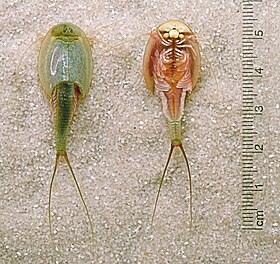Talk:Triops longicaudatus
| This article is rated B-class on Wikipedia's content assessment scale. It is of interest to the following WikiProjects: | |||||||||||
| |||||||||||
Untitled
[edit]Triops longicaudatus fossils are NOT 200 Million years old. USA Fossil studies have shown that they only existed ~70 Million years ago.
People are misquoting the fossil studies of Triops cancriformis.
Some toy companies selling these Triops kits are even quoting 500 Million years! --Quatermass 10:41, 28 September 2007 (UTC)
http://unclemilton.com/products/Back2Nature/LiveHab/DeluxeAquasaurs.html is one of the toy companies selling the kits and their manual:
http://www.unclemilton.com/company/manuals/AquasaursManual.pdf
is one of the ones making these claims.
--Kitterma (talk) 03:14, 28 April 2009 (UTC)
Also, as "living fossils" go, wouldn't that make them relatively unimpressive? As I understand current mainstream science, many extant animals are older than dinosaurs, which is hundreds of millions of years.. like, turtles and crocodiles and... sharks. —Preceding unsigned comment added by 75.73.70.113 (talk) 00:15, 3 December 2009 (UTC)
Sharks are older than dinosaurs, but turtles and crocodiles are about the same age, all three reptile groups are about 200 million years old if I remember correctly (just to clarify, the third group is dinosaurs, not sharks which are fish and not reptiles). — Preceding unsigned comment added by 24.36.148.242 (talk) 03:24, 19 August 2011 (UTC)
NOTE: This article is currently being rewritten and thoroughly checked for unverified claims by me. All the correct information in the article is going to stay, but the misquotes have to GO. --Crustaceanguy (talk) 00:51, 26 January 2008 (UTC)
pollution and triops
[edit]How do Triops react to pollutants in the water. I have look in several places, but only found out that they are a threat to rice patties. TripleA AAA (talk) 23:53, 5 November 2008 (UTC)
Like any other freshwater shrimp invertebrate. They are quite sensitive to metals for example. --Quatermass (talk) 19:11, 11 August 2009 (UTC)
Commercial sites
[edit]Are links to companies which selling these creatures allowed? I'm thinking of Wikipedia's help page External_links#Links_normally_to_be_avoided - section 5 - Links to web pages that primarily exist to sell products or services. If no one objects after a suitable time, I'll delete them. --Quatermass (talk) 19:11, 11 August 2009 (UTC)
I second their removal. The website referenced isn't even a good reference for information on the subject. Spreggo (talk) 22:05, 3 September 2009 (UTC)
dinosaurs
[edit]"... to survive the natural disasters that may have killed the dinosaurs 66 million years ago" may??? 66??? Dinosaurs did NOT go extinct all at once. mass extinctions occur regularly and even today. https://en.wikipedia.org/wiki/Extinction_event Therefore changed. Rangutan (talk) 08:47, 12 February 2014 (UTC)
File:Triops-longicaudatus-dorsal-ventral-edit2.jpg to appear as POTD soon
[edit]Hello! This is a note to let the editors of this article know that File:Triops-longicaudatus-dorsal-ventral-edit2.jpg will be appearing as picture of the day on November 25, 2012. You can view and edit the POTD blurb at Template:POTD/2012-11-25. If this article needs any attention or maintenance, it would be preferable if that could be done before its appearance on the Main Page so Wikipedia doesn't look bad. :) Thanks! —howcheng {chat} 19:18, 24 November 2012 (UTC)
Assessment comment
[edit]The comment(s) below were originally left at Talk:Triops longicaudatus/Comments, and are posted here for posterity. Following several discussions in past years, these subpages are now deprecated. The comments may be irrelevant or outdated; if so, please feel free to remove this section.
| Comment(s) | Press [show] to view → |
|---|---|
Most of the information in the article is good, but a few things stand out:
There are also some small minor formatting issues (units, n-dashes for ranges of numbers) and a couple of typos, but they can be dealt with later. For now, referencing the text is the most pressing task. --Stemonitis 16:46, 15 August 2007 (UTC)
| |
Last edited at 00:04, 2 September 2007 (UTC). Substituted at 09:16, 30 April 2016 (UTC)
New picture available
[edit]
Please consider if useful for the page. --Dans (talk) 07:55, 14 August 2022 (UTC)


